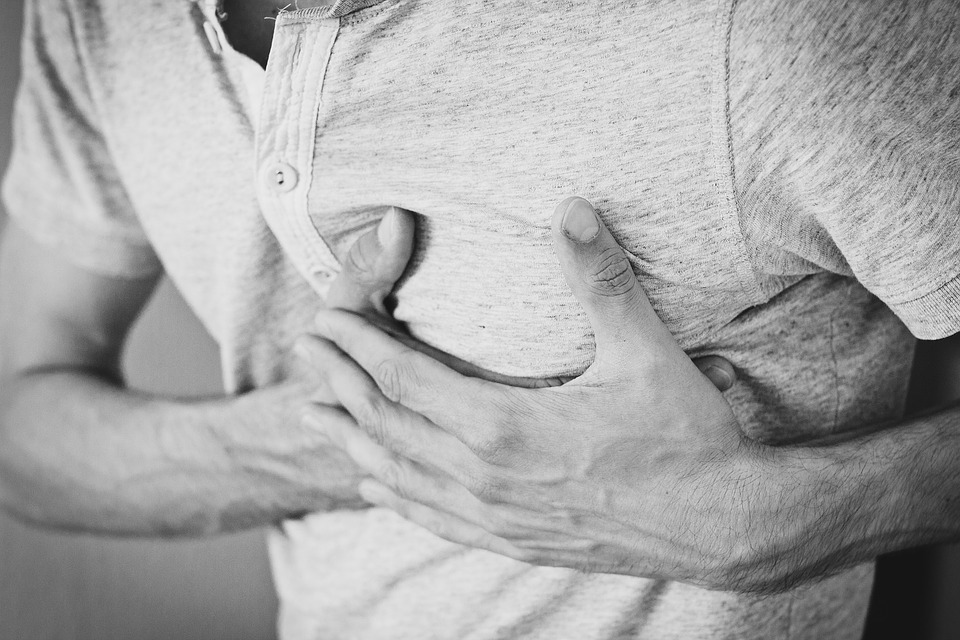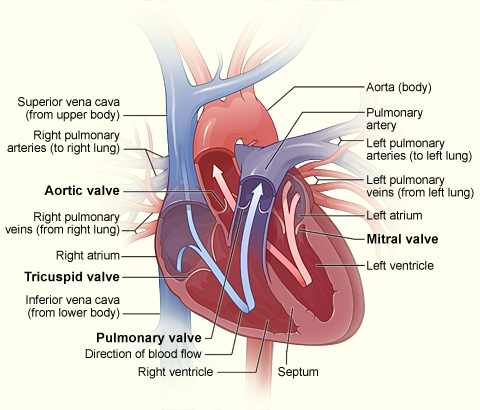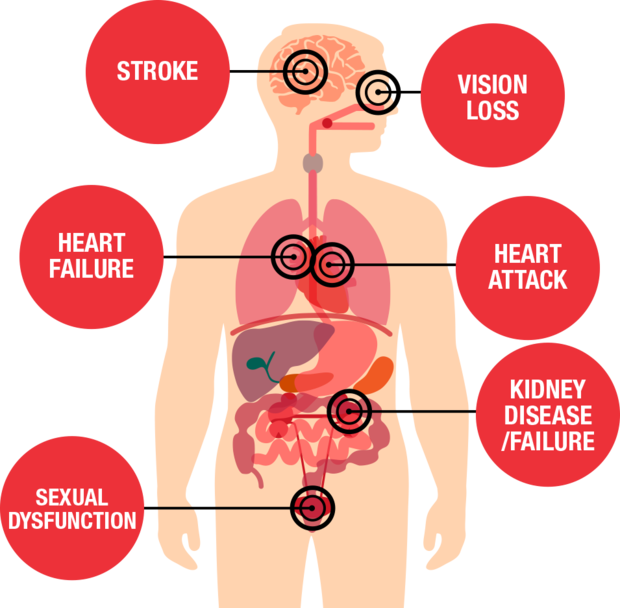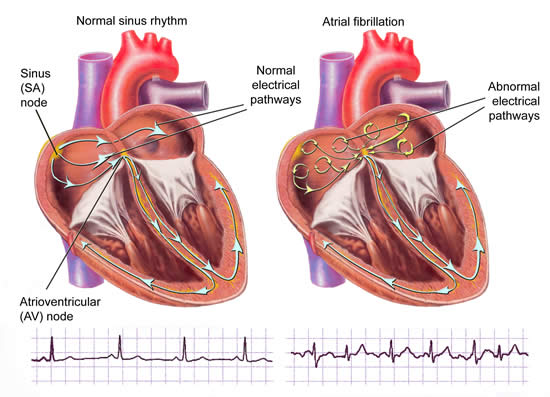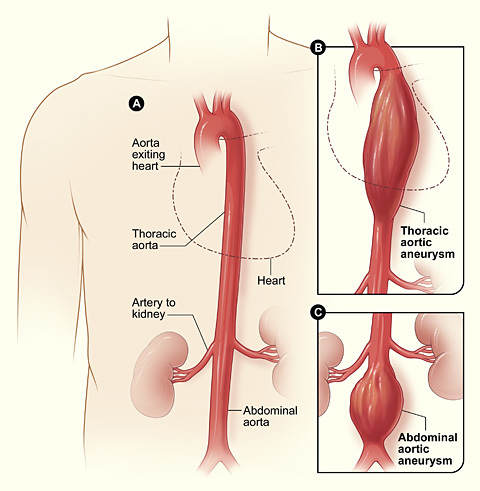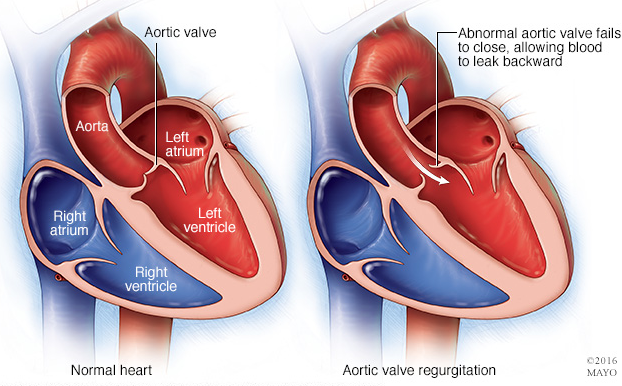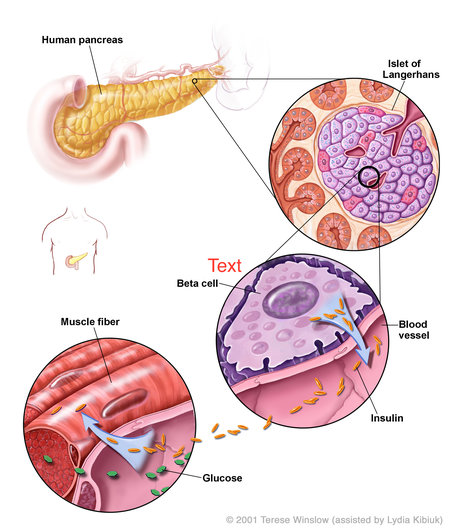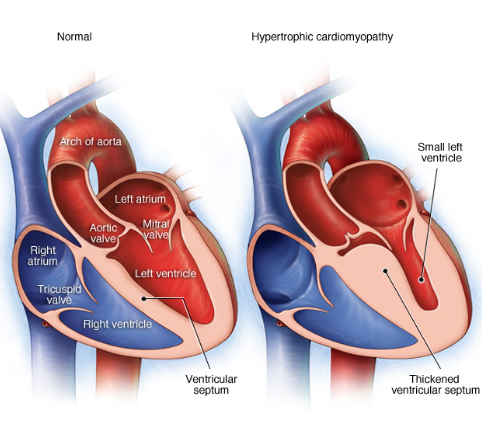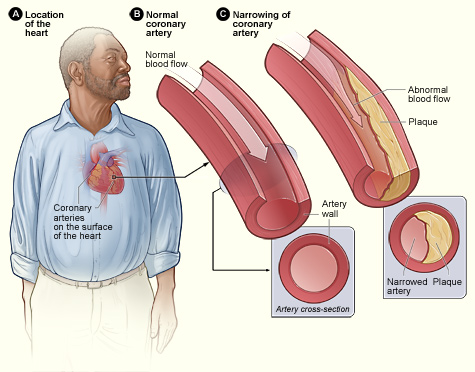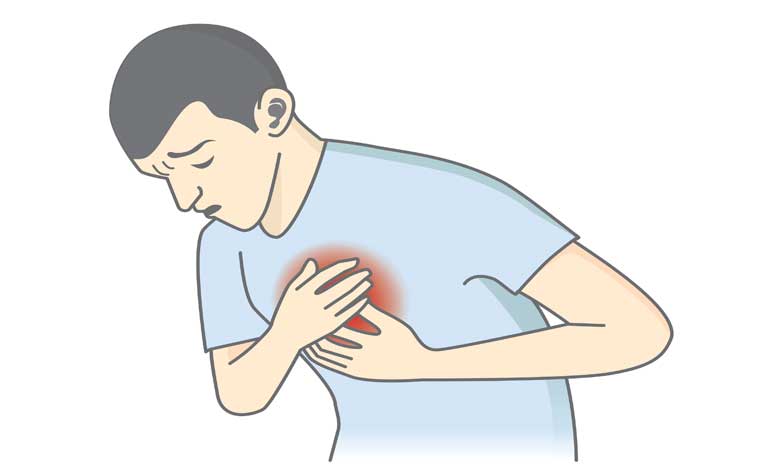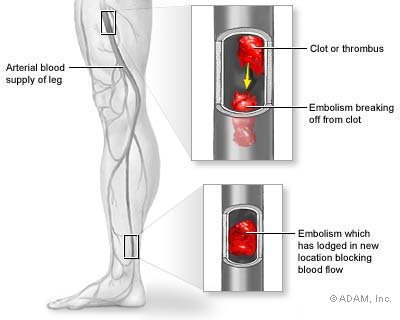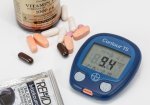Cardiovascular Disease Symptoms and Treatment, an In-depth List
Cardiovascular disease symptoms range widely depending on the underlying disease. Although there is repeated reference to cardiovascular disease also known in short as CVD as a single disease, as a matter of fact CVD represents quite a huge cluster of diseases that go by a variety of names.

In many cases cardiovascular disease has been mostly talked about in a manner that limits it to heart disease, heart failure and sometimes stroke. However, these are just a part of the bigger scope of cardiovascular diseases.
We recommend a look at our in-depth definition of cardiovascular found here which should help a great deal appreciating the following cardiovascular disease symptoms and treatment as listed.
Let's get started...
Cardiovascular Disease Symptoms and Treatment List
The following are cardiovascular diseases and their respective symptoms and possible treatment options.
Myocardial infarction
Image Credit: NIH
While the name used here my not be common, the medical issue itself is very common and is refereed to in simple terms as heart attack. A heart attack or acute myocardial infarction occurs when oxygen-rich blood is blocked from reaching a section of the heart muscle. When this happens that section begins to die unless blood flow is restored quickly. Myocardial infarction is itself often a result of coronary heart disease (CHD) which we list below. Plaque and blood clots can block arteries leading to a heart attack.
Symptoms of a Heart Attack
- Chest pain (from left arm to neck)
- Breathlessness
- Cold sweating
- Nausea
- Vomiting
- Abnormal heart beat
- Anxiety
- Fatigue
- Weakness
- Stress
- Depression
Treatment of a Heart Attack
- Aspirin (taken immediately to dissolve clots)
- Oxygen (administered immediately to improve supply)
- Nitro-glycerin/pain killers (for chest pain)
- Diet control (prevention and aftermath)
- Blood pressure monitoring (prevention and aftermath)
- Cardiovascular exercise (prevention and aftermath)
Hypertension
Image Credit: AHA
Hypertension also known as high blood pressure is a cardiovascular disorder that is predominant in many populations globally. When considering cardiovascular disease symptoms, hypertension is largely asymptomatic the reason why it is called a silent killer. The causes of hypertension are genetic in nature but predominantly lifestyle related.
Symptoms of Hypertension
Because high blood pressure has no apparent symptoms, the following signs (which are also considered complications) may appear due to hypertension after damage has already been done
- Eye damage
- Aneurysms (abnormal artery bulge)
- Kidney disease
- Cognitive changes (memory loss, difficulty finding words, focus loss during conversations)
- Sexual dysfunction
- Loss of Vision
Treatment of Hypertension
Often, people mention dizziness, headaches, and weakness among a long list of supposedly high blood pressure symptoms. A 1988 study in the Journal of Hypertension (1988 Nov;6(1):S87-90) concluded that "these symptoms do not constitute a reliable criterion for starting antihypertensive treatment or judging its efficacy".
- Lifestyle changes (diet, smoking, drinking)
- Weight loss
- Regular exercise
- Herbal remedies
- Acupuncture
- Relaxation
- Pharmaceutical drugs
Irregular heartbeat
Irregular heartbeat also known as atrial fibrillation, cardiac arrhythmia or simply arrhythmia is a disorder were the heart beats to fast or too slow or beat with an irregular rhythm. This is caused by a misfiring of electrical signals in the heart's chambers. The heart has an electrical system which is responsible for the beating rhythm. Some of the underlying causes include damage following a heart attack, heart surgery and heart muscle changes. While irregular heartbeat can be harmless, for the most part, in some cases it can be life threatening.
Arrhythmia Symptoms
- Palpitations
- Feeling of heart skipping a beat
- Heart beating too hard
- Anxiety (serious)
- Weakness (serious)
- Shortness of breath (serious)
- Chest pain (serious)
- Dizziness (serious)
Treatment of Arrhythmia
- Lifestyle changes (e.g caffeine, tobacco, alcohol)
- Surgery
- Medication
- Devices e.g pacemaker
- Regular physical activity
Aneurysms (artery enlargement)
Image Credit: PubMed Health
Aneurysms is yet another cardiovascular disease whose symptoms and treatment varies depending on the extent of the problem. The real causes is not known although physicians posit that weakening damage caused to blood vessels by plaque and high blood pressure could be responsible. Risk factors are being over 60, of Caucasian ethnicity, smoking and hypertension according to a 2011 review published in the journal Experimental and Clinical Cardiology (2011 Spring; 16(1): 11–15).
Mostly occurring in the aorta, brain, intestine, spleen or back of the knee, aneurysms refers to the enlargement or ballooning of an artery or blood vessel. The fatality of aneurysms depends on whether or not it raptures. Symptoms vary based on where it occurs. Furthermore, symptoms may also only present when the enlargement has burst.
Symptoms of Aneurysms
- Bleeding
- Higher heart rate
- Pain
- Dizziness
- Lightheaded
- Numbness
- Swelling
- Overall, asymptomatic and discovered incidental in many cases
Treatment of Aneurysms
- Surgery (for repair or reinforcement)
- Medicines (to lower blood pressure)
- Lowering blood pressure
- Lifestyle changes (i.e quitting smoking)
Stroke
Image Credit: National Cancer Institute
No consideration of cardiovascular disease symptoms and treatment is complete without including cerebrovascular accident commonly refereed to as stroke. Even more loosely, its been called brain attack. In a more or less similar fashion as heart attack, stroke occurs when a portion of the brain is deprived of oxygen rich blood. Brain cells in that area begin to die after a few minutes. Bleeding in the brain that damages brain cells is also another frequent cause of stroke.
Symptoms of Stroke
- Sudden weakness
- Paralysis
- Numbness (face, arms, legs)
- Failure of speech
- Failure of sight
- Confusion/Failure to understand
- Disability (complication)
- Brain damage (complication)
Treatment of Stroke
- Surgery (e.g removal of plaque)
- Medications (including blood thinners)
- Speech therapy
- Lowering blood pressure
- Physical therapy
- Cardiovascular Exercise (with or without equipment)
- Quitting smoking
- Overall, treatment of stroke follows set stroke management guidelines as articulated here in a review published in the journal Annals of Indian Academy of Neurology (2011 Jul; 14(Suppl1): S82–S96.)
Heart Valve Disease
Heart valve disease is a cardiovascular disease were one or more of the heart's valves ceases working properly due to an infection, birth defect or ageing. Other conditions other than these may also result in heart valve disease. There are at least another 17 names by which this same disorder or disease is known including aortic stenosis, aortic sclerosis, congenital valve disease, and tricuspid regurgitation.
Symptoms of Heart Valve Disease
- Unusual heartbeat sound (heart murmur heard using a stethoscope)
- Fatigue (sign of advancement to heart failure)
- Shortness of breath (sign of advancement to heart failure)
- Swelling (ankles, stomach, legs, feet, veins, neck)
- Dizziness
- Fainting
- Chest pain
Treatment of Heart Valve Disease
- Surgery (replacement or repair)
- Lifestyle changes (e.g better oral health to reduce chances of infection)
- Quitting smoking
- Healthy diet (incl. low fat dairy products)
- Medicines (for heart failure, cholesterol, blood thinning etc)
- Lowering blood pressure
Metabolic syndrome
Image Credit: PubMed
As we ponder on cardiovascular disease symptoms and treatment, things get a little complex when we consider metabolic syndrome. In a similar fashion has cardiovascular disease, metabolic syndrome represents a cluster of health problems linked to an increased risk of heart disease and type 2 diabetes. The particular health conditions are high blood pressure, high fat levels (triglyceride) in the blood, a large waist, above normal blood glucose levels and low HDL cholesterol levels.
Symptoms of Metabolic syndrome
As could be deduced from the risk factors making up metabolic syndrome, mots of them such as hypertension and high triglyceride levels have no apparent symptoms. Except for a large waist which of itself is not conclusive, there is need for lab tests to be conducted in order to confirm metabolic syndrome. However, risk is also a risk factor which in the United States Mexican-Americans are considered at higher risk.
Treatment of Metabolic syndrome
- Heart-healthy lifestyle modifications (first line treatment)
- Lowering blood pressure
- Lowering triglycerides
- Controlling high blood sugar
- Lowering LDL cholesterol
- Managing stress
- Quitting smoking
- Exercise
- Medicines (to prevent clots, sudden death)
Cardiomegaly
Cardiomegaly is also simply known as enlarged heart. The heart may enlarge due to hypertension or coronary heart disease. Other causes include a damaged heart valve, previous heart attack, old age, obesity, pregnancy, alcohol, HIV infection and thyroid disease according to Better Health Channel. As the enlargement continues, the heart reaches a point were its unable pump blood leading to heart failure.
Symptoms of Cardiomegaly
- Shortness of breath (most common)
- Swelling of the ankles (most common)
- Chest pain (rare)
- Dizziness (rare)
- Palpitations
- Feeling tired
Treatment of Cardiomegaly
- Pacemaker fitment (to coordinate contractions)
- Bypass surgery
- Heart valve surgery
- Heart transplant (treatment of last resort)
Coronary Heart Disease (CHD)
Of all considerations of cardiovascular disease symptoms, causes and treatment coronary heart disease is among the most discussed. This is easy to understand when the prevalence of CHD and its potential complications are considered. CHD occurs when waxy substance gradually blocks the coronary artery leading to hypertension, blood clots, heart attack and even heart failure among many other problems. A 2016 review published in the journal Annals of Translational Medicine (2016 Jul; 4(13): 256) stated that CHD is a leading cause of death and disability in advanced countries.
Symptoms of Coronary Heart Disease
- Maybe asymptomatic (important to note)
- Angina (chest pain)
- Increased heart rate
- Nausea
- Sweating
- Lightheadness
- Ingestion
- Heart attack (complication)
- Heart failure (complication)
Treatment of Coronary Heart Disease
- Lifestyle modifications
- Exercise and fitness
- Quitting smoking
- Heating healthy/Low fat diet
- Medicines (blood thinners, cholesterol)
- Surgery ( e.g revascularization)
Cardiac Arrest
Just as the others we have already considered, no discussion on cardiovascular disease symptoms, causes and treatment could be complete without the mention of cardiac arrest. In fact cardiac arrest has featured prominently in mentions of cardiovascular disease in both medical literature and general health information.
Cardiac arrest is not the same as heart attack although the two are repeatedly confused. It is the sudden loss of heart function, breathing and even consciousness. It is usually a result of an electric disturbance in the heart's function. According to the American Heart Association (AHA), cardiac arrest maybe a result of arrhythmias or irregular heartbeat discussed earlier.
Symptoms of Cardiac Arrest
Cardiac arrest often occurs without any warning whatsoever. However, the following are some of the symptoms that may occur.
- Sudden loss of responsiveness (even when asked if OK)
- Gasping and no breathing
- Sudden collapse
- No pulse
- Vomiting (preceding cardiac arrest)
- Dizziness (preceding)
- Chest pain (preceding)
- Blackouts (preceding)
- Palpitations (preceding)
Treatment of Cardiac Arrest
Quitting smoking
Stopping alcohol
Weight loss
Exercise
Lowering blood pressure
Nutritional balance e.g. potassium and magnesium
Racing heartbeat
Cardiopulmonary resuscitation (CPR)
Automated external defibrillators (AEDs)
Surgery (e.g coronary artery bypass grafting)
Arterial Embolism (vessel blockage)
Image Credit: ADAM
Arterial embolism also known as vessel blockage is a cardiovascular problem that is caused by a blood clot, air bubble,mass of tissue or a foreign substance blocking the arteries. It is among one of the highly concerning cardiovascular disease symptoms. Embolism maybe a symptom of other cardiovascular problems such as plaque in the arteries which dislodge and then block the free flow of blood in the arteries. There are different types of embolism depending on how and where they occur in the body.
A 2013 report carried in the International Journal of Critical Illness and Injury Science noted that:-
Surgical and intensive care patients are at a heightened risk for arterial embolization due to pre-existing conditions such as age, hypercoagulability, cardiac abnormalities and atherosclerotic disease
Symptoms of Arterial Embolism
- Pale skin
- Lack of movement (if in leg/arm)
- Chest pain
- Lower pulse (arm/leg)
- Muscle spasm
- Numbness or tingling (arm/leg)
- Blisters
- Stroke (complication)
- Heart attack (complication)
Treatment of Arterial Embolism
- Surgery (e.g arterial by-pass, embolectomy)
- Medication (blood thinners)
- Pain killers via IV
Apparently, this list of cardiovascular disease symptoms and treatment options demonstrates that there is more to cardiovascular disease than first meets the eye. Cardiovascular disease is a broad . What is also clear is that cardiovascular problems are very much interrelated so much that one single problem has potential to trigger a chain of other problems sometimes with fatal outcomes.
[Last updated: 14 November 2017]

|
Home > Cardiovascular Disease Symptoms |
Cardiovascular > Cardiovascular Disease Symptoms |
Disclaimer
Information contained on this website is not meant to replace your doctor's advice.
(c) All Rights Reserved. 2010-2018
